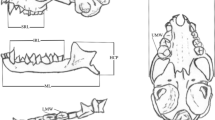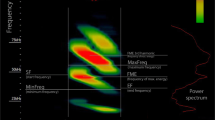Abstract.
The allotonic frequency hypothesis proposes that certain insectivorous bat species can prey upon moths that can hear bat echolocation calls by using echolocation frequencies outside the sensitivity range of moth ears. The hypothesis predicts that the peak frequencies of bat echolocation calls are correlated with the incidence of moths in the diets of these bats. The aim of this study was to test this prediction on a bat community dominated by bats using low duty cycle echolocation calls, i.e. aerial foraging, insectivorous species using frequency modulated calls. The community consisted of nine species, two molossids, Sauromys petrophillus and Tadarida aegyptiaca, five vespertilionids, Eptesicus capensis, Eptesicus hottentotus, Miniopteris schreibersii, Myotis tricolor, and Myotis lesueuri, one rhinolophid, Rhinolophus clivosus, and one nycterid, Nycteris thebaica. The insect fauna in the habitat used by the bat community was suited to the testing of the allotonic frequency hypothesis because more than 90% of the moths comprising the insect fauna were tympanate. These included Pyralidae (3.8%), Geometridae (44.9%), Notodontidae (3.8%), Arctiidae (4.6%), Lymantriidae (0.8%) and Noctuidae (32.4%). As predicted, peak echolocation frequency was correlated with the incidence of moths in the diets of these nine species (r=0.98, df=7, P<0.01). Furthermore, multivariate analysis revealed that echolocation frequency (t=9.91, n=129, P<0.001) was a better predictor of diet than forearm length (t=5.51, n=129, P<0.001) or wing area (t=–3.41, n=129, P<0.001). This suggests that the selection pressure exerted by moth hearing might have acted directly on call frequency and secondarily on body size and wing morphology, as part of the same adaptive complex. It is unlikely that dietary differences were due to temporal and spatial differences in the availability of prey because the pattern of differences in skull morphology of the nine species supported our dietary analyses. The skull morphology of a bat represents a historical record of the kind of diet it has become adapted to over its evolutionary history. These results suggest that prey defences may mediate other factors structuring bat communities, e.g. competition. Competition may be reduced for those species of bats that can circumvent prey defences.
Similar content being viewed by others
Author information
Authors and Affiliations
Additional information
Electronic Publication
Rights and permissions
About this article
Cite this article
Schoeman, C.M., Jacobs, D.S. Support for the allotonic frequency hypothesis in an insectivorous bat community. Oecologia 134, 154–162 (2003). https://doi.org/10.1007/s00442-002-1107-1
Received:
Accepted:
Issue Date:
DOI: https://doi.org/10.1007/s00442-002-1107-1




